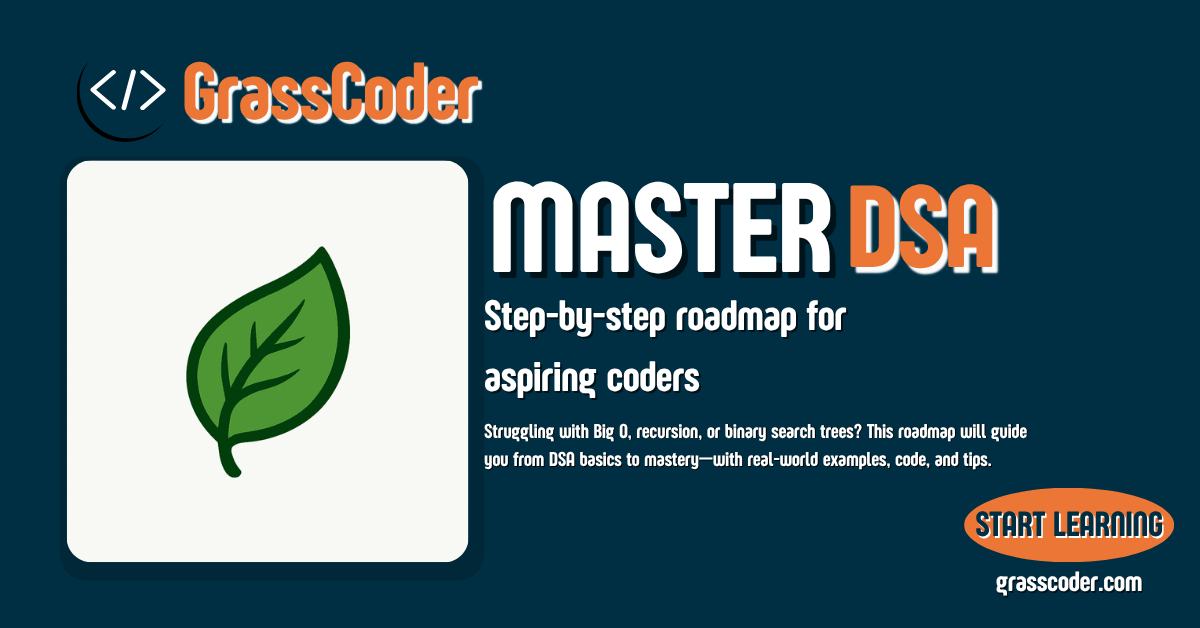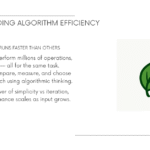Many developers can build solid web apps and write decent code, but the moment terms like “Big O notation” or “binary search trees” come up, it’s enough to trigger a cold sweat. Sound familiar?
If you’re reading this, you’re probably in the same boat. Maybe you’re preparing for technical interviews, or perhaps you’ve realized that understanding DSA is crucial for writing efficient code. Either way, you’re in for quite a journey—and I’m here to guide you through it.
I want to share the complete roadmap that took me from DSA novice to confident problem-solver. This isn’t just a normal roadmap—it’s step-by-step guide to mastering one of the most important skills in programming.
Why This Matters
Before we dive into the roadmap, let me tell you why DSA isn’t just academic fluff:
A search feature was taking a few seconds to find results. After using a better method with the right data structure—like a list replaced by a hash table—it started giving results almost instantly. Just knowing the right tool made everything faster.
DSA isn’t about memorizing algorithms. It’s about developing a toolkit of problem-solving techniques that will make you a better programmer, period.
Your Complete Learning Path: 8 Essential Phases
Phase 1: Foundation – Big O Notation & Analysis (Week 1-2)
“Understanding the language of efficiency”
This is where everything begins. You can’t optimize what you can’t measure.
What you’ll learn:
- How to analyze time and space complexity
- Why some solutions are better than others
- The mathematics behind algorithm analysis
Key concepts:
// Understanding why this is O(n²)
function findPairs(array) {
for (let i = 0; i < array.length; i++) {
for (let j = i + 1; j < array.length; j++) {
console.log(array[i], array[j]);
}
}
}
// Versus this O(n) solution
function processArray(array) {
for (let i = 0; i < array.length; i++) {
console.log(array[i]);
}
}
Real-world application: Understanding Big O helpe to realize why our user search was slow. We were using a nested loop approach (O(n²)) when we could use a hash table lookup (O(1)).
Master these topics:
- Time complexity analysis
- Space complexity considerations
- Big O of common operations (arrays, objects)
- When to prioritize time vs space
Phase 2: Problem-Solving Fundamentals (Week 3-4)
“Learning to think like a programmer”
Raw algorithmic knowledge isn’t enough. You need a systematic approach to tackle any problem.
The 5-step problem-solving framework:
- Understand the Problem
// Example: "Write a function that checks if two strings are anagrams"// Questions to ask:// - What defines an anagram?// - Case sensitive?// - What about spaces and punctuation?// - What should we return? - Explore Concrete Examples
// Input: "listen", "silent" → Output: true// Input: "hello", "world" → Output: false// Input: "A man, a plan, a canal: Panama" → ? - Break It Down
function isAnagram(str1, str2) {// 1. Remove non-alphanumeric characters// 2. Convert to lowercase// 3. Check if lengths are equal// 4. Count character frequencies// 5. Compare frequencies } - Solve or Simplify
function isAnagram(str1, str2) {
// Clean the strings
const clean1 = str1.replace(/[^a-zA-Z0-9]/g, '').toLowerCase();
const clean2 = str2.replace(/[^a-zA-Z0-9]/g, '').toLowerCase();
if (clean1.length !== clean2.length) return false;
// Count frequencies
const freq1 = {};
const freq2 = {};
for (let char of clean1) {
freq1[char] = (freq1[char] || 0) + 1;
}
for (let char of clean2) {
freq2[char] = (freq2[char] || 0) + 1;
}
// Compare frequencies
for (let char in freq1) {
if (freq1[char] !== freq2[char]) return false;
}
return true;
}5. Look Back and Refactor
// More elegant solution
function isAnagram(str1, str2) {
const normalize = str => str.replace(/[^a-zA-Z0-9]/g, '').toLowerCase().split('').sort().join('');
return normalize(str1) === normalize(str2);
}Phase 3: Essential Problem-Solving Patterns (Week 5-7)
“The secret weapons of competitive programmers”
These patterns are your Swiss Army knife for solving 80% of coding problems.
Pattern 1: Frequency Counter
When to use: Comparing pieces of data or their frequencies
// Problem: Find if array1 contains squares of array2
function same(arr1, arr2) {
if (arr1.length !== arr2.length) return false;
const freq1 = {};
const freq2 = {};
for (let val of arr1) {
freq1[val] = (freq1[val] || 0) + 1;
}
for (let val of arr2) {
freq2[val] = (freq2[val] || 0) + 1;
}
for (let key in freq1) {
if (!(key ** 2 in freq2)) return false;
if (freq2[key ** 2] !== freq1[key]) return false;
}
return true;
}
Pattern 2: Multiple Pointers
When to use: Searching for pairs in sorted arrays
// Problem: Find pair that sums to zero
function sumZero(arr) {
let left = 0;
let right = arr.length - 1;
while (left < right) {
const sum = arr[left] + arr[right];
if (sum === 0) {
return [arr[left], arr[right]];
} else if (sum > 0) {
right--;
} else {
left++;
}
}
return undefined;
}
Pattern 3: Sliding Window
When to use: Finding subarrays or substrings
// Problem: Find maximum sum of n consecutive elements
function maxSubarraySum(arr, num) {
if (num > arr.length) return null;
let maxSum = 0;
let tempSum = 0;
// Calculate sum of first window
for (let i = 0; i < num; i++) {
maxSum += arr[i];
}
tempSum = maxSum;
// Slide the window
for (let i = num; i < arr.length; i++) {
tempSum = tempSum - arr[i - num] + arr[i];
maxSum = Math.max(maxSum, tempSum);
}
return maxSum;
}
Pattern 4: Divide and Conquer
When to use: Breaking problems into smaller subproblems
// Binary search implementation
function binarySearch(arr, val) {
let left = 0;
let right = arr.length - 1;
while (left <= right) {
const mid = Math.floor((left + right) / 2);
if (arr[mid] === val) {
return mid;
} else if (arr[mid] < val) {
left = mid + 1;
} else {
right = mid - 1;
}
}
return -1;
}
Phase 4: Recursion Mastery (Week 8-10)
“The art of elegant problem-solving”
Recursion is where many developers get stuck, but it’s essential for understanding advanced data structures.
The recursion mindset:
- Base case – When do we stop?
- Recursive case – How do we make the problem smaller?
// Simple recursion example
function factorial(n) {
// Base case
if (n <= 1) return 1;
// Recursive case
return n * factorial(n - 1);
}
// More complex: Fibonacci with memoization
function fibonacci(n, memo = {}) {
if (n in memo) return memo[n];
if (n <= 2) return 1;
memo[n] = fibonacci(n - 1, memo) + fibonacci(n - 2, memo);
return memo[n];
}
// Helper method recursion
function collectOdds(arr) {
const result = [];
function helper(input) {
if (input.length === 0) return;
if (input[0] % 2 !== 0) {
result.push(input[0]);
}
helper(input.slice(1));
}
helper(arr);
return result;
}
// Pure recursion
function collectOddsPure(arr) {
let newArr = [];
if (arr.length === 0) return newArr;
if (arr[0] % 2 !== 0) {
newArr.push(arr[0]);
}
newArr = newArr.concat(collectOddsPure(arr.slice(1)));
return newArr;
}
Phase 5: Searching and Sorting Algorithms (Week 11-13)
“The building blocks of efficient programs”
Searching Algorithms
Linear Search – O(n)
function linearSearch(arr, val) {
for (let i = 0; i < arr.length; i++) {
if (arr[i] === val) return i;
}
return -1;
}
Binary Search – O(log n)
function binarySearch(arr, val) {
let left = 0;
let right = arr.length - 1;
while (left <= right) {
const mid = Math.floor((left + right) / 2);
if (arr[mid] === val) return mid;
else if (arr[mid] < val) left = mid + 1;
else right = mid - 1;
}
return -1;
}
Sorting Algorithms
Bubble Sort – O(n²)
function bubbleSort(arr) {
for (let i = arr.length; i > 0; i--) {
for (let j = 0; j < i - 1; j++) {
if (arr[j] > arr[j + 1]) {
[arr[j], arr[j + 1]] = [arr[j + 1], arr[j]];
}
}
}
return arr;
}
Merge Sort – O(n log n)
function mergeSort(arr) {
if (arr.length <= 1) return arr;
const mid = Math.floor(arr.length / 2);
const left = mergeSort(arr.slice(0, mid));
const right = mergeSort(arr.slice(mid));
return merge(left, right);
}
function merge(arr1, arr2) {
const result = [];
let i = 0, j = 0;
while (i < arr1.length && j < arr2.length) {
if (arr1[i] < arr2[j]) {
result.push(arr1[i]);
i++;
} else {
result.push(arr2[j]);
j++;
}
}
while (i < arr1.length) {
result.push(arr1[i]);
i++;
}
while (j < arr2.length) {
result.push(arr2[j]);
j++;
}
return result;
}
Quick Sort – O(n log n) average
function quickSort(arr, left = 0, right = arr.length - 1) {
if (left < right) {
const pivotIndex = pivot(arr, left, right);
quickSort(arr, left, pivotIndex - 1);
quickSort(arr, pivotIndex + 1, right);
}
return arr;
}
function pivot(arr, start = 0, end = arr.length - 1) {
const pivot = arr[start];
let swapIdx = start;
for (let i = start + 1; i <= end; i++) {
if (pivot > arr[i]) {
swapIdx++;
[arr[swapIdx], arr[i]] = [arr[i], arr[swapIdx]];
}
}
[arr[start], arr[swapIdx]] = [arr[swapIdx], arr[start]];
return swapIdx;
}
Phase 6: Data Structures Deep Dive (Week 14-18)
“The containers that shape efficient programs”
Linked Lists
When to use: Dynamic size, frequent insertions/deletions
class Node {
constructor(val) {
this.val = val;
this.next = null;
}
}
class SinglyLinkedList {
constructor() {
this.head = null;
this.tail = null;
this.length = 0;
}
push(val) {
const newNode = new Node(val);
if (!this.head) {
this.head = newNode;
this.tail = newNode;
} else {
this.tail.next = newNode;
this.tail = newNode;
}
this.length++;
return this;
}
pop() {
if (!this.head) return undefined;
let current = this.head;
let newTail = current;
while (current.next) {
newTail = current;
current = current.next;
}
this.tail = newTail;
this.tail.next = null;
this.length--;
if (this.length === 0) {
this.head = null;
this.tail = null;
}
return current;
}
get(index) {
if (index < 0 || index >= this.length) return null;
let current = this.head;
let count = 0;
while (count !== index) {
current = current.next;
count++;
}
return current;
}
}
Stacks and Queues
Stack – LIFO (Last In, First Out)
class Stack {
constructor() {
this.first = null;
this.last = null;
this.size = 0;
}
push(val) {
const newNode = new Node(val);
if (!this.first) {
this.first = newNode;
this.last = newNode;
} else {
const temp = this.first;
this.first = newNode;
this.first.next = temp;
}
return ++this.size;
}
pop() {
if (!this.first) return null;
const temp = this.first;
if (this.first === this.last) {
this.last = null;
}
this.first = this.first.next;
this.size--;
return temp.val;
}
}
Queue – FIFO (First In, First Out)
class Queue {
constructor() {
this.first = null;
this.last = null;
this.size = 0;
}
enqueue(val) {
const newNode = new Node(val);
if (!this.first) {
this.first = newNode;
this.last = newNode;
} else {
this.last.next = newNode;
this.last = newNode;
}
return ++this.size;
}
dequeue() {
if (!this.first) return null;
const temp = this.first;
if (this.first === this.last) {
this.last = null;
}
this.first = this.first.next;
this.size--;
return temp.val;
}
}
Binary Search Trees
When to use: Sorted data, fast search/insertion/deletion
class BSTNode {
constructor(val) {
this.val = val;
this.left = null;
this.right = null;
}
}
class BinarySearchTree {
constructor() {
this.root = null;
}
insert(val) {
const newNode = new BSTNode(val);
if (!this.root) {
this.root = newNode;
return this;
}
let current = this.root;
while (true) {
if (val === current.val) return undefined;
if (val < current.val) {
if (!current.left) {
current.left = newNode;
return this;
}
current = current.left;
} else {
if (!current.right) {
current.right = newNode;
return this;
}
current = current.right;
}
}
}
find(val) {
if (!this.root) return false;
let current = this.root;
while (current) {
if (val === current.val) return true;
else if (val < current.val) current = current.left;
else current = current.right;
}
return false;
}
// Breadth-First Search
BFS() {
const visited = [];
const queue = [];
if (this.root) queue.push(this.root);
while (queue.length) {
const node = queue.shift();
visited.push(node.val);
if (node.left) queue.push(node.left);
if (node.right) queue.push(node.right);
}
return visited;
}
// Depth-First Search - PreOrder
DFSPreOrder() {
const visited = [];
function traverse(node) {
visited.push(node.val);
if (node.left) traverse(node.left);
if (node.right) traverse(node.right);
}
if (this.root) traverse(this.root);
return visited;
}
}
Phase 7: Advanced Data Structures (Week 19-21)
“The specialized tools for complex problems”
Heaps and Priority Queues
class MaxBinaryHeap {
constructor() {
this.values = [];
}
insert(val) {
this.values.push(val);
this.bubbleUp();
}
bubbleUp() {
let idx = this.values.length - 1;
const element = this.values[idx];
while (idx > 0) {
const parentIdx = Math.floor((idx - 1) / 2);
const parent = this.values[parentIdx];
if (element <= parent) break;
this.values[parentIdx] = element;
this.values[idx] = parent;
idx = parentIdx;
}
}
extractMax() {
const max = this.values[0];
const end = this.values.pop();
if (this.values.length > 0) {
this.values[0] = end;
this.sinkDown();
}
return max;
}
sinkDown() {
let idx = 0;
const length = this.values.length;
const element = this.values[0];
while (true) {
const leftChildIdx = 2 * idx + 1;
const rightChildIdx = 2 * idx + 2;
let leftChild, rightChild;
let swap = null;
if (leftChildIdx < length) {
leftChild = this.values[leftChildIdx];
if (leftChild > element) {
swap = leftChildIdx;
}
}
if (rightChildIdx < length) {
rightChild = this.values[rightChildIdx];
if (
(swap === null && rightChild > element) ||
(swap !== null && rightChild > leftChild)
) {
swap = rightChildIdx;
}
}
if (swap === null) break;
this.values[idx] = this.values[swap];
this.values[swap] = element;
idx = swap;
}
}
}
Hash Tables
class HashTable {
constructor(size = 53) {
this.keyMap = new Array(size);
}
_hash(key) {
let total = 0;
const WEIRD_PRIME = 31;
for (let i = 0; i < Math.min(key.length, 100); i++) {
const char = key[i];
const value = char.charCodeAt(0) - 96;
total = (total * WEIRD_PRIME + value) % this.keyMap.length;
}
return total;
}
set(key, value) {
const index = this._hash(key);
if (!this.keyMap[index]) {
this.keyMap[index] = [];
}
this.keyMap[index].push([key, value]);
}
get(key) {
const index = this._hash(key);
if (this.keyMap[index]) {
for (let i = 0; i < this.keyMap[index].length; i++) {
if (this.keyMap[index][i][0] === key) {
return this.keyMap[index][i][1];
}
}
}
return undefined;
}
values() {
const valuesArr = [];
for (let i = 0; i < this.keyMap.length; i++) {
if (this.keyMap[i]) {
for (let j = 0; j < this.keyMap[i].length; j++) {
if (!valuesArr.includes(this.keyMap[i][j][1])) {
valuesArr.push(this.keyMap[i][j][1]);
}
}
}
}
return valuesArr;
}
keys() {
const keysArr = [];
for (let i = 0; i < this.keyMap.length; i++) {
if (this.keyMap[i]) {
for (let j = 0; j < this.keyMap[i].length; j++) {
if (!keysArr.includes(this.keyMap[i][j][0])) {
keysArr.push(this.keyMap[i][j][0]);
}
}
}
}
return keysArr;
}
}
Graphs
class Graph {
constructor() {
this.adjacencyList = {};
}
addVertex(vertex) {
if (!this.adjacencyList[vertex]) {
this.adjacencyList[vertex] = [];
}
}
addEdge(v1, v2) {
this.adjacencyList[v1].push(v2);
this.adjacencyList[v2].push(v1);
}
removeEdge(v1, v2) {
this.adjacencyList[v1] = this.adjacencyList[v1].filter(v => v !== v2);
this.adjacencyList[v2] = this.adjacencyList[v2].filter(v => v !== v1);
}
removeVertex(vertex) {
while (this.adjacencyList[vertex].length) {
const adjacentVertex = this.adjacencyList[vertex].pop();
this.removeEdge(vertex, adjacentVertex);
}
delete this.adjacencyList[vertex];
}
depthFirstRecursive(start) {
const result = [];
const visited = {};
const adjacencyList = this.adjacencyList;
function dfs(vertex) {
if (!vertex) return null;
visited[vertex] = true;
result.push(vertex);
adjacencyList[vertex].forEach(neighbor => {
if (!visited[neighbor]) {
dfs(neighbor);
}
});
}
dfs(start);
return result;
}
breadthFirst(start) {
const queue = [start];
const result = [];
const visited = {};
visited[start] = true;
while (queue.length) {
const vertex = queue.shift();
result.push(vertex);
this.adjacencyList[vertex].forEach(neighbor => {
if (!visited[neighbor]) {
visited[neighbor] = true;
queue.push(neighbor);
}
});
}
return result;
}
}
Phase 8: Advanced Algorithms (Week 22-24)
“The algorithms that power modern systems”
Dijkstra’s Algorithm
class PriorityQueue {
constructor() {
this.values = [];
}
enqueue(val, priority) {
this.values.push({val, priority});
this.sort();
}
dequeue() {
return this.values.shift();
}
sort() {
this.values.sort((a, b) => a.priority - b.priority);
}
}
class WeightedGraph {
constructor() {
this.adjacencyList = {};
}
addVertex(vertex) {
if (!this.adjacencyList[vertex]) {
this.adjacencyList[vertex] = [];
}
}
addEdge(vertex1, vertex2, weight) {
this.adjacencyList[vertex1].push({node: vertex2, weight});
this.adjacencyList[vertex2].push({node: vertex1, weight});
}
Dijkstra(start, finish) {
const nodes = new PriorityQueue();
const distances = {};
const previous = {};
let path = [];
let smallest;
// Build up initial state
for (let vertex in this.adjacencyList) {
if (vertex === start) {
distances[vertex] = 0;
nodes.enqueue(vertex, 0);
} else {
distances[vertex] = Infinity;
nodes.enqueue(vertex, Infinity);
}
previous[vertex] = null;
}
// As long as there is something to visit
while (nodes.values.length) {
smallest = nodes.dequeue().val;
if (smallest === finish) {
// Build path to return
while (previous[smallest]) {
path.push(smallest);
smallest = previous[smallest];
}
break;
}
if (smallest || distances[smallest] !== Infinity) {
for (let neighbor in this.adjacencyList[smallest]) {
let nextNode = this.adjacencyList[smallest][neighbor];
let candidate = distances[smallest] + nextNode.weight;
let nextNeighbor = nextNode.node;
if (candidate < distances[nextNeighbor]) {
distances[nextNeighbor] = candidate;
previous[nextNeighbor] = smallest;
nodes.enqueue(nextNeighbor, candidate);
}
}
}
}
return path.concat(smallest).reverse();
}
}
Dynamic Programming
// Fibonacci with memoization
function fibMemo(n, memo = {}) {
if (n in memo) return memo[n];
if (n <= 2) return 1;
memo[n] = fibMemo(n - 1, memo) + fibMemo(n - 2, memo);
return memo[n];
}
// Fibonacci with tabulation
function fibTab(n) {
if (n <= 2) return 1;
const fibNums = [0, 1, 1];
for (let i = 3; i <= n; i++) {
fibNums[i] = fibNums[i - 1] + fibNums[i - 2];
}
return fibNums[n];
}
// Coin change problem
function coinChange(coins, amount) {
const dp = new Array(amount + 1).fill(Infinity);
dp[0] = 0;
for (let i = 1; i <= amount; i++) {
for (let coin of coins) {
if (coin <= i) {
dp[i] = Math.min(dp[i], dp[i - coin] + 1);
}
}
}
return dp[amount] === Infinity ? -1 : dp[amount];
}
Your Study Strategy: Making It Stick
Weekly Schedule Template
Monday: Theory & Concepts (2 hours)
- Watch lectures/read materials
- Take notes on key concepts
- Draw diagrams for complex topics
Tuesday: Implementation Practice (2 hours)
- Code along with examples
- Implement data structures from scratch
- Debug and test your implementations
Wednesday: Problem Solving (2 hours)
- Solve practice problems
- Apply patterns learned
- Time yourself on problems
Thursday: Review & Optimization (1.5 hours)
- Review previous day's solutions
- Optimize for better time/space complexity
- Identify common mistakes
Friday: Project Day (2 hours)
- Build something using the week's concepts
- Create visualizations
- Write explanatory blog posts
Weekend: Assessment & Planning (1 hour)
- Take quizzes
- Assess understanding
- Plan next week's focus areas
Essential Tools & Resources
For Practice:
- LeetCode (start with Easy problems)
- HackerRank
- CodeSignal
- Cracking the Coding Interview book
For Visualization:
- VisuAlgo.net
- Algorithm Visualizer
- Big O Cheat Sheet
For Implementation:
- VS Code with debugging
- Chrome DevTools for performance
- Git for version control
Common Pitfalls to Avoid
Fix: Practice thinking out loud while coding.
- Rushing Through Fundamentals
Skipping Big O or problem-solving patterns to “get to the cool stuff” will hurt you later.
Fix: Spend extra time on Phase 1-3—they’re the foundation of everything else.
2. Memorizing Instead of Understanding
Reciting code snippets won’t help in interviews or real-world debugging.
Fix: Ask why an algorithm works. Can you explain it to a rubber duck?
3. Ignoring Edge Cases
Writing code that passes basic tests but fails on empty inputs, duplicates, or large datasets.
Fix: Test with:javascript// Empty arrays, single-item arrays, large inputs, negative numbers [], [1], [1,1,1], Array(1000000).fill(0)
4. Overlooking Space Complexity
Optimizing for speed but using O(n²) memory.
Fix: Always ask: “Can I use less memory?” (e.g., in-place swaps vs. new arrays).
5. Avoiding Recursion
Fear of stack overflows leads to missed elegant solutions (e.g., tree traversals).
Fix: Practice with:javascript// Sum numbers from 1 to n recursively function sumRange(n, total = 0) { if (n <= 0) return total; return sumRange(n – 1, total + n); }
6. Cramming Instead of Consistency
Studying 10 hours on Saturday but nothing all week = poor retention.
Fix: Stick to the *2-hour daily* schedule—small wins compound.
7. Not Using Visualizations
Struggling to “see” linked lists or trees in your head.
Fix: Draw them! (Tools: Excalidraw, paper & pencil.)
8. LeetCode Grind Without Reflection
Solving 100 problems but not recognizing patterns.
Fix: After each problem, write down:
Pattern used (e.g., sliding window)
Time/Space Complexity
Alternative approaches
9. Neglecting Real-World Applications
Not connecting BSTs to databases or heaps to priority queues.
Fix: Ask: “Where is this used in production?” (e.g., GPS → Dijkstra’s).
10. Ignoring Soft Skills
Mumbling through explanations in interviews.
Fix: Practice thinking out loud while coding.
Final Tip: Keep a learning journal—note mistakes, “aha” moments, and patterns. Review it weekly!
Thanks, Hope You Enjoyed.





